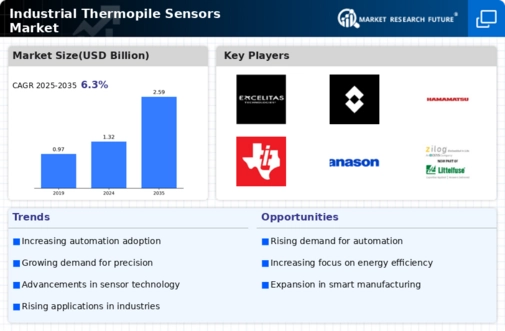Market Trends
Key Emerging Trends in the Industrial Thermopile Sensors Market
The Industrial Thermopile Sensors Market is witnessing several noteworthy trends that are shaping its current landscape. One prominent trend is the increasing adoption of IoT (Internet of Things) and Industry 4.0 technologies across industries. As manufacturing processes become more connected and data-driven, there is a growing demand for advanced sensing solutions like industrial thermopile sensors. These sensors play a pivotal role in collecting and transmitting temperature data in real-time, contributing to the overall efficiency and optimization of industrial operations.
Another significant trend is the focus on miniaturization and integration of industrial thermopile sensors into compact devices. With advancements in microelectronics and sensor design, manufacturers are developing smaller and more integrated thermopile sensors. This trend is particularly crucial in applications where space is limited, allowing for the incorporation of temperature sensing capabilities in various compact and portable devices.
Energy harvesting capabilities represent a noteworthy trend in the Industrial Thermopile Sensors Market. Manufacturers are increasingly focusing on developing sensors that can harness and convert ambient thermal energy into electrical power. This energy harvesting feature not only enhances the sustainability of sensor applications but also reduces the dependence on external power sources, making industrial thermopile sensors more versatile and cost-effective.
The emergence of wireless communication technologies is also influencing the market trends of industrial thermopile sensors. Integration with wireless protocols such as Bluetooth and Wi-Fi enables seamless connectivity, allowing for remote monitoring and control. This trend is particularly beneficial in industrial settings where accessibility and mobility are essential, contributing to the increased adoption of industrial thermopile sensors in diverse applications.
The demand for high-temperature measurement capabilities is another trend driving the market. Industries operating in extreme environments, such as metal processing, aerospace, and automotive, require sensors that can accurately measure and withstand elevated temperatures. Manufacturers are responding to this trend by developing industrial thermopile sensors with enhanced temperature ranges and robust designs to meet the specific needs of high-temperature applications.
Customization and application-specific solutions are gaining prominence in the Industrial Thermopile Sensors Market. As industries become more specialized and diverse, there is a growing demand for sensors that can be tailored to specific application requirements. Manufacturers are offering customizable options, allowing end-users to choose sensors with specific sensitivities, response times, and other features that align with their unique application needs.
The emphasis on data analytics and predictive maintenance is influencing the adoption of industrial thermopile sensors. By leveraging the data generated by these sensors, industries can implement predictive maintenance strategies, minimizing downtime and optimizing equipment performance. This trend aligns with the broader industry shift towards proactive and data-driven maintenance practices.
Environmental monitoring and safety compliance are also driving market trends in the Industrial Thermopile Sensors Market. With increasing awareness of workplace safety and environmental regulations, industries are investing in sensors that can provide accurate and reliable temperature measurements in various settings. Industrial thermopile sensors, with their non-contact measurement capabilities, are well-suited for such applications, contributing to the growing demand in these sectors.












Leave a Comment